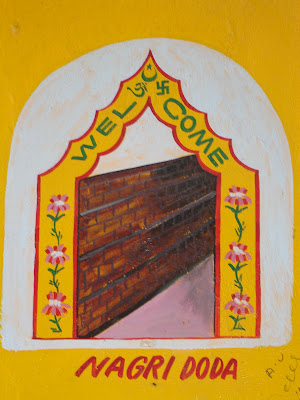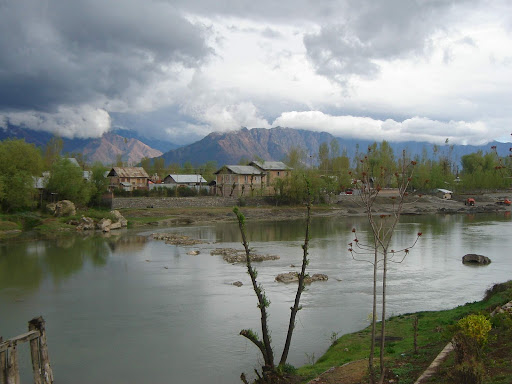By Yoginder Sikand, TwoCircles.net,
The violence that is rapidly engulfing large parts of Jammu and Kashmir, set off by a controversial government decision to grant a tract of land to a temple trust in Kashmir, threatens to totally disrupt the already tenuous inter-communal relations in the region. This has frightening portents particularly for those parts of the state where Hindus and Muslims both live in substantial numbers, such as Rajouri, Poonch and Doda, all in the Jammu province. Economic interdependence and shared cultural bonds and traditions between the communities in these areas had kept communal rivalries in check, and people had, over time, evolved their own mechanisms to relate to each other despite their differences. Now, this delicate social fabric might, if the ongoing agitation continues unabated, tear apart.

The towering mountains of Doda, thickly carpeted with evergreen forests, dotted with tiny hamlets and home to roughly equal numbers of Hindus and Muslims. I’ve been visiting the district every year for the last almost two decades. Militant Muslim outfits and Hindu chauvinist groups both have a presence in the region. Yet, strong ties bind other Hindus and Muslims and have halted the complete polarization of the populace. This is something that I’ve been attempting to study for years now. How do ordinary Hindus and Muslims, as distinct from men who claim to speak for them, look at and relate to each other? What theological resources can be marshaled to challenge the politics of communal chauvinists such as those fomenting the present spate of violence in the wake of the Amarnath controversy?
With the onset of militancy in Doda in the early 1990s, everyone says, Hindu-Muslim relations rapidly deteriorated. There seems to be a near total consensus on this point. Says Mangat, an elderly shopkeeper in Udarana, a mixed Hindu-Muslim village near the town of Bhaderwah, ‘Now we hardly visit each other’s homes or patronize each other’s shops. We are cordial to each other when we meet, and some Hindus and Muslims invite each other for marriages, but that is all. We really don’t have love in our hearts for each other.’
But it is not that before militancy erupted in Doda inter-communal relations were entirely cordial. Says Sharma, ‘In 1947, several Muslims, were killed by Hindu and Sikh mobs, in league with the Maharaja’s forces. Some Hindus were killed in Bhalesa, a Muslim-majority part of Doda. Under Shaikh Abdullah, radical land reforms were introduced in the state, through which share-croppers, mainly Muslims and Dalits, got land previously owned by Rajput and Brahmin landlords, and this naturally incensed the upper castes, who felt their dominance was being undermined.’
Till 1947, Sharma adds, most Muslims were landless labourers, and there were only a few small Muslim traders in the region. Along with the Dalits, they were also treated as untouchables by the ‘upper’ caste Hindus and forced to do begar or unpaid labour for the Hindu landlords. Changes after 1947 led to the emergence of a sizeable educated Muslim middle-class, who were now able to compete with the traditionally dominant ‘upper’ caste Hindus for government jobs and power. The nature of politics of the district, then, naturally began to change. It took a rapid turn for the worse with the rise of militancy in Kashmir and of Hindu chauvinist groups in Doda and beyond.

Doda sufi shrine
Zia Hussain, a shopkeeper in Doda town, points out that in large parts of Doda, Hindus and Muslims live in the same localities, as neighbours. ‘The sort of ethnically separated and divided localities that you have in places like Delhi and UP are totally absent here’, he says. ‘Earlier, Doda was cut off from the rest of the state due to the difficult mountainous terrain. We were, to a large extent, insulated from communal conflicts elsewhere. But now, with the rapid expansion of roads and communications facilities, new ideas brought in by communal forces, both Hindu and Muslim, have begun to take root. If any communal clash takes place somewhere in India, news travels at once to Doda and makes a sharp impact here.’ ‘Militancy in the Kashmir Valley and oppression of Muslims in India, not any major local conflicts, lie at the root of growing Hindu-Muslim divisions in Doda’ he argues.
Certain new forms of religion being introduced from outside the state are playing havoc with traditional understandings of communal identity. A large number of temples across Doda are now controlled by pujaris from Uttar Pradesh and Bihar. Rampant unemployment in these states, plus the fact that few Brahmins from Doda would now consider working in temples as a career option, account in part for this. Many of these pujaris from outside are ardent supporters of the Hindu right-wing, fiercely anti-Muslim and disdainful of the ‘low’ castes, and that message is subtly put across to their followers. In contrast to the few local pujaris that remain, who, being rooted in local cultural traditions, a product of centuries of co-existence with Muslims, are considerably more accommodative of their Muslim neighbours, some of these new pujaris consider Muslims as mortal enemies. And then there is the rapid intrusion of new forms of Hinduism, the cults of various Babas and the orthodox, more exclusivist Brahmanic Vaishnavite tradition, in a region earlier characterized by the worship of local, possibly pre-Aryan snake gods and the cult of Shiva.
This is paralleled on the Muslim side with the decline of the tradition of the Sufi Pirs, and the concomitant rise of more exclusivist Islamic groups like the Tablighi Jamaat and, to a lesser extent, the Jamaat-e Islami, both of which consider key aspects of the culture of local Muslims as ‘un-Islamic’ and who are less accommodative of Hindus than the Sufis were. Under Tablighi influence, growing numbers of Muslims have started keeping long beards and shaving their moustaches, wearing skull-caps and keeping their shalwars above their ankles, imitating the Deobandi model of Islam preached by itinerant Tablighi activists. These are visible markers of distinction, probably intended to set off Muslims from others.
Religion is being marshaled as the prime vehicle to foment communal divisions by both Hindu and Muslim groups, but there are possibilities of it being used for precisely the opposite purpose. Says Sajjad, a Muslim student from Bhaderwah, ‘The Quran says that God has sent prophets to every nation, and so it is possible that some of the religious figures of the Hindus were also prophets. Islam teaches us that we must relate to all non-Muslims who do not oppress or oppose us with love and concern. Self-styled militants who kill innocents in the name of jihad are doing the work of the devil. They are motivated simply by power and pelf, not for the sake of God, and so what they are doing cannot be called jihad. They have zikr-e khuda (the name of God) on their lips, but their hearts are empty of fikr-e khuda (remembrance of God’). Some people wrongly think that picking up the sword against all non-Muslims is jihad, but, actually, doing anything good, even speaking a good word to someone, is a jihad.’
‘Hindu chauvinists are no different,’, says his Hindu friend Raja. ‘Mooh Mai Ram-Ram, Baghal Mai Churi (‘They have Ram’s name on their lips and hide a knife in their hands’).’

Doda view
‘Our principal task as Muslims is to tell others about Islam, through love and good deeds’ explains Abdul Hai, a shopkeeper in Kishtwar town. ‘As long as we are allowed to freely practice our religion, we cannot declare jihad. Taking up arms, as some of us have, just to set up a separate state or join another state or for any such worldly purpose cannot be called a jihad.’ ‘But’, he goes on, ‘when we look at how Muslims are being persecuted in India, how efforts are being made to destroy Article 370 that guarantees a special status for Jammu and Kashmir, how armed forces goes around killing innocent Muslims here in Doda and elsewhere in our state and how Hindutva forces seek to destroy us, we Muslims, even those of us who are vociferously opposed to the militants, naturally become increasingly apprehensive.’
Despite the communal divide, there are no organised forums in Doda to promote inter-community dialogue. Some fear that to vocally speak in favour of peace and harmony might invite the wrath of their co-religionists or even possible death. Or, perhaps it is just indifference. As Suleiman, a village elder from Kulhand, says, ‘Maybe our youth have become too materialistic, indifferent to such social concerns.’
But at the same time as communal identities have become increasingly polarized, large numbers of Hindus and Muslims still privately insist on the need for cordial relations and do their own bit in that regard in their own ways: jointly demonstrating against the slaughter of innocent villagers in a remote village, pooling resources to rescue people trapped in an avalanche or injured in a road mishap, or simply pointing out that true religion teaches love and that, as the tired clichés go, ‘God is one’ and ‘Everyone’s blood is red’.
From the last five years onwards, things began limping back to a semblance of ‘normality’ in Doda. The number of killings by militants and the armed forces registered a rapid decline. Long spells of curfew were done away with. As were the army checkpoints that had come up at every kilometer or so on the road connecting Doda with Jammu. My friends in Doda, Hindus and Muslims, were ecstatic about the prospects of peace. But now, with the on-going agitation in Jammu and in Kashmir over the Amarnath yatra, that might be a mere chimera if things are allowed to spin out of control, as they indeed seem to be.
